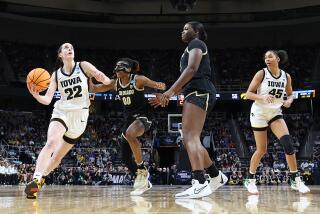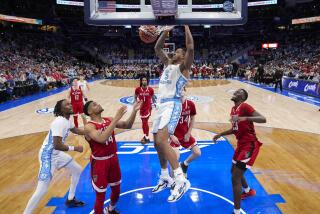March Madness puts Davidson math professor in a bracket of his own
Mathematician Tim Chartier has the best job on Earth once a year: when the NCAA men’s basketball tournament begins, so does March Mathness.
His telephone rings, he’s on the radio, he’s talking to ESPN, and for once he can explain what exactly he does for a living at North Carolina’s Davidson College.
“For the first time in my life I can talk about what I’m doing, on a higher level, and people understand,” Chartier said.
What Chartier does is use complex math to win the Final Four pool on a regular basis. How regular a basis? He’s been in the top 3% of the 4 million submissions to ESPN’s March Madness tournament challenge, which is arguably the major league of sports prognostication.
“That’s when we said, whoa, this thing really works,” Chartier said of his brush with sports handicapping superstardom.
Blame it on tiny Butler College. Chartier’s math class was among those to recognize that fifth-seeded Butler was destined for the finals in 2010. That was the second year Chartier started making bracketology -- the art and science of picking winners among 68 teams in a single-elimination tournament -- part of his syllabus. That’s right: take Chartier’s course and you’ll be deep into basketball come March. He’s even written a research paper on it.
“We use bracketology to test new ideas in sports ranking,” Chartier said.
There’s something in it for Chartier. He gets to use a pool of undergraduates as researchers whose choices for weighing one team’s record against another’s helps him evaluate mathematical models. And he gets them interested in the mathematics of complex linear systems.
The basketball team at Davidson, a tiny and selective liberal arts college, is seeded 14th in the tournament’s East regional, for the record. Chartier is true to his school, but truer to his math. He’s not picking his home team to win -- although he notes that it’s on a 17-game winning streak, and likely will come out with a higher ranking than most handicappers give it.
Chartier is going with ... well, let’s do some math first.
Each team in the tournament comes in with a seeding, a relative ranking based on their records and somebody else’s math. Don’t worry, this won’t be on the final exam. “We don’t look at the seeding at all,” Chartier said.
Students divide up the season into segments, and begin assigning weights to games played at different times. “I may treat the beginning games as a fourth of a game. You win a fourth, I lose a fourth.” But when a team shows it can beat a better team late in the season, those games may get a higher weight.
“That’s how we found these upsets,” he said.
But then it gets weird and complex. Students start figuring out what else they may want to weight. One student asked a hockey player for advice, and arrived at weighting games that are part of a win streak (such as Davidson, right now). Others may lend weight to close games against well-ranked opponents. This is the art part of the exercise. But they have to justify their choices, and figure out how to make it work.
The students then run their data through two basic algorithms based on matrices, vectors and some calculus. The Colley Method, created by astrophysicist Wesley Colley, and the Massey Method, created by Ken Massey as an undergraduate honors thesis at Bluefield College in Virginia, may not sound familiar, but they’re behind most of the rankings you see on sports shows, particularly when it comes time to pick college football teams for bowl games. The Colley method, which can factor in the “quality” of wins or losses, got a black eye this year.
“That’s the one that everyone went crazy over when they ranked Notre Dame over Alabama,” Chartier said. The Crimson Tide rolled all over the Irish in the BCS national championship game, though. The Massey system didn’t make that mistake.
Chartier starts his classes late this time of year, and watches his students huddle and argue over what to weight, how to do it and whether it works. They’re learning more than he can possibly teach in those moments, he says.
Up for the challenge? You can learn the whole system online through udemy.com. “I’ve had people from a couple different colleges using and adapting that course,” he said. Among them this year is a local middle-school teacher in nearby Charlotte, N.C., using a simplified version.
Not everyone who takes Chartier’s course is a math or sports fan. Some are the “math last” students trying to fulfill a graduation requirement in senior year. Others are serious math wonks who may not have watched more than a competitive chess game. “They don’t know much about sports, but they say, hey, there’s this big math problem,” Chartier said.
NCAA Division I athletes can’t participate in his tournament contest, because technically it’s gambling -- even though the reward is a coupon for Ben and Jerry’s ice cream. “The person who gets that will be happier about it than about any grade,” Chartier said. “Part of it is just bragging rights.”
What you wind up with is some 350 equations and 350 unknowns, formed from some 5,000 Division I games.
“I teach the students how you would do it by hand, but we do it by computer,” he said. “A computer does it extremely fast. That’s what blows their minds.”
So, who did Chartier pick? With a simplified Massey method (which gives his students a fighting chance), he agrees with Dick Vitale: Louisville wins it all, in this case beating Florida, then Indiana, which beats Gonzaga.
By the Colley method, the Final Four are Duke, Kansas, New Mexico and Miami, with New Mexico winning.
Which system will do the best?
“That’s the madness for us in the math!” Chartier said.







